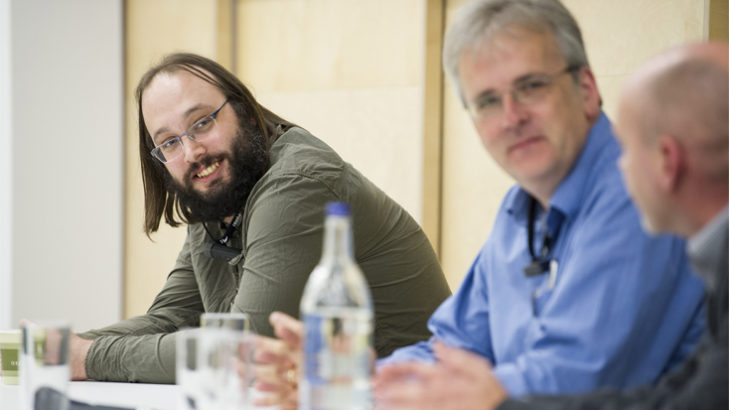Guest Post: Inspiring New Science

Lei Tan is a PhD student from Queen Mary University of London under the guidance of three supervisors: Prof. Martin Dove, Dr Andrei Sapelkin and Dr Alston Misquitta. She is currently studying the structure of metal chalcogenide nanoclusters, in particular a group called magic-size clusters that have an extremely small size (knowledge of their structures at an atomic level is critical for further understanding). In her work, Tan combines experiment methods (xray total scattering, neutron scattering) and simulation (DFT and Reverse Mont-Carlo modelling), requiring large amounts of CPU time. She is one of the pilot users of the Thomas supercomputer.
I feel lucky to have been able to attend Powering Up Research, since all of the afternoon’s talks were related in some way to my research and greatly inspired me.
The first session was a review of materials science. It is not easy to give a comprehensive and profound review and summary of the development of materials science, but Prof Angelos Michaelides and Prof Mark Miodownik gave excellent talks on the history of the development of materials science. The future of manufacturing depends on a number of technological breakthroughs in robotics, sensors and high-performance computing, to name a few and new materials change both the manufacturing process and the end result.
Once the conference kicked off, the first inspiring lecture was from Dr. Fransesca Baletto who is using the classical Molecular Dynamics method to study the growth of small free platinum–cobalt nanoclusters, applying a novel deposition method when doing the simulation. The second excellent talk was by Chris Pickard on the subject of random structure searching; finding the most stable structure of a material corresponding to the global minimum energy state is crucial when we do structure prediction. Chris Pickard’s code “Ab-initio random structure searching (AIRSS)” answered this question excellently. If nothing is known about the likely low- energy structures it is reasonable to start searching by relaxing random structures, which gives the widest coverage of the potential energy surface and an unbiased sampling cite. To improve the efficiency of the searches, constraints on the initial structures were set so that our “random structures” might better be described as “random sensible structures”.
“The facility has given me a lot of help, running quickly and smoothly. The response from the Thomas IT service was also so quick when I reported some questions to them”
The third talk by Rachel Crespo Ostero inspired me by how time-dependent DFT can be used in the modelling of aggregation-induced emission in molecular crystals. The fifth talk by Prof. Daniele Dini revolved around advanced modelling of surfaces and interfaces with a focus on tribological application. His talk linked the properties of materials with structure at different levels, from electrons in an atom to the whole system. Multiscale modelling is crucial for the design of materials, such as how to arrange and connect different materials and then get the final result of a material with properties with superior properties. The finale Q&A session was really a useful and meaningful session, with many questions about the Thomas supercomputer asked and answered live.Overall, I spent a meaningful afternoon by attending Powering Up Research. There are different research field in materials science, and it is not easy to understand all the aspects related to this field (such as from atomic structure aspect, experiment aspect, multi-scaling modeling aspect etc.), however the conference included many topics from across the field. The speakers invited are from different research fields with varying backgrounds, which inspire me to think of my own research from other angles and broaden my mind. Undertaking research is not about working in an isolated fashion, and collaboration and listening to other researchers’ work may inspire us towards new ideas and thoughts. The launch also provided useful information from the panel, such as how to get help more efficiently, updates of the modules and how to get a program compiled in Thomas successfully etc.; all practical suggestions that help Thomas users, including me, use the supercomputer more efficiently.

